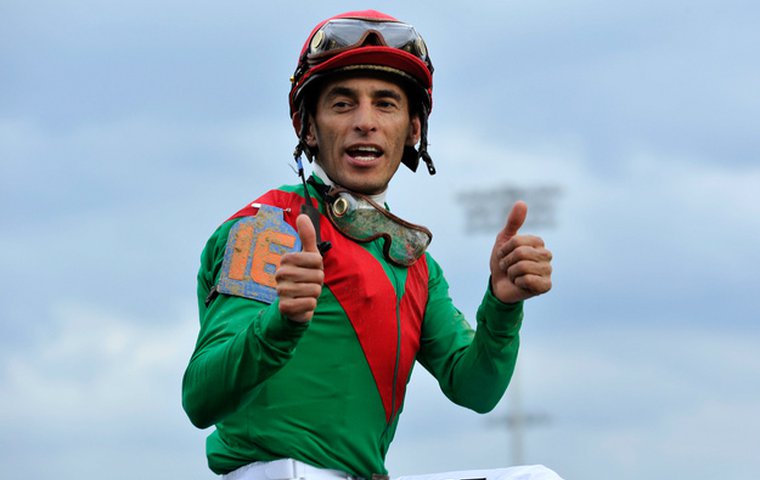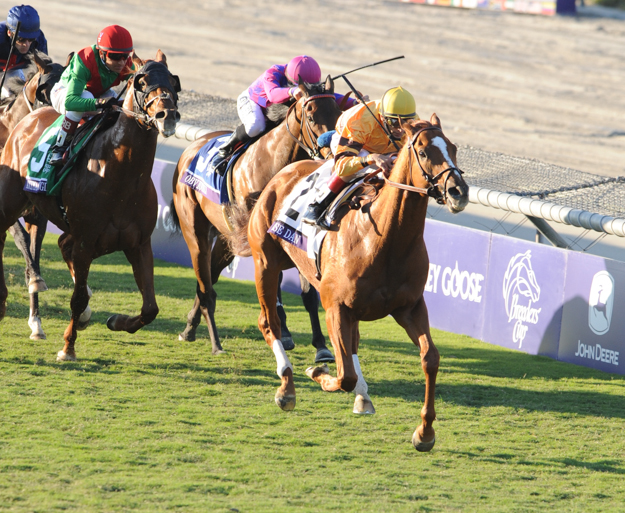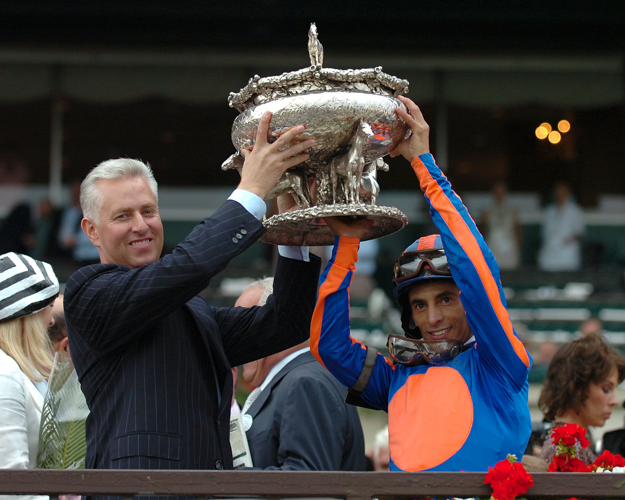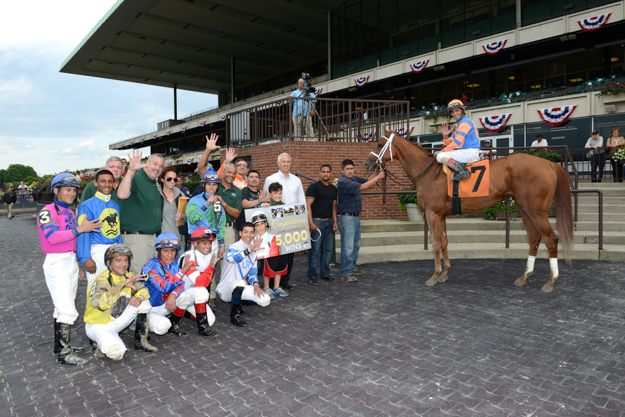
This year will mark jockey John Velazquez’s 19th Breeders’ Cup appearance. With 12 previous winners at North America’s year-end Championships, the 42-year-old rider is tied for fourth among the event’s top riders by victories.
Last year at Santa Anita, Velazquez could not add to that tally. Winless on Day One, the rider suffered life-threatening injuries when his first Breeders’ Cup mount on Saturday, Secret Compass, suffered a broken leg during the running of the Juvenile Fillies.
Velazquez made his name on the New York circuit, arriving in the United States from Puerto Rico in 1990 on the advice of Hall of Fame jockey Angel Cordero, Jr., who upon his retirement several years later became Velazquez’s agent.
Inducted into the National Museum of Racing’s Hall of Fame in 2012 and perennially among the leading riders in the U.S., Velazquez is a two-time Eclipse Award winner. He won the Belmont Stakes twice, aboard the filly Rags to Riches in 2007 and Union Rags in 2012. Velazquez’s first Kentucky Derby winner came aboard Animal Kingdom in 2011. He is the owner of 26 individual riding titles at New York Racing Association tracks.
On Oct. 13, 2013 at Belmont Park, Velazquez surpassed Pat Day’s mark of $297 million in earnings to become North America’s all-time leading money-earning jockey. Another career milestone occurred in June 2013 at Belmont Park when he rode his 5,000th winner.
Chairman of the Jockey’s Guild, and on the Board of the Permanently Disabled Jockeys Fund, Velazquez is an outspoken advocate for the welfare and safety of riders.
The regular rider for leading Breeders’ Cup Juvenile contender Carpe Diem, it was recently announced that Velazquez would replace the injured Rajiv Maragh aboard Main Sequence for the Breeders’ Cup Turf. Velazquez lost his marquee Breeders’ Cup horse when Wise Dan was ruled out of the Breeders’ Cup Mile with an injury, but is now expected to ride Grand Arch in that race.
Karen M. Johnson interviewed John Velazquez on Oct. 1.
----------
It’s nearly a year now since your accident. Are you still affected by the loss of your spleen?
“Not having the spleen means my energy level goes up and down. When my kids are sick, I can feel my energy level gets pretty low. I try, with help from supplements, vitamins, not to get sick. It is something I have to watch. The doctors told me right after the accident that I had to be careful around people who are sick because I don’t have my spleen, which aids the immune system.
“Another thing that is happening and I don’t understand why, so I will ask my doctor at my next appointment, is that my weight has not been the same since the accident. I constantly have to eat more to maintain my weight a little higher. When I ride, I lose weight a lot quicker than I did before the accident.”
What are your recollections of the spill?
“I remember everything. From the time I fell, from the time I told someone I was about to pass out and I kneeled on the track, to the time they put me in the ambulance . . . I never really passed out.
“I felt pressure in my ribs. I thought I broke a rib and hurt my knee. When I got to the hospital, all these doctors and nurses were surrounding me and I was like, ‘holy crap.’ People were everywhere. I was still pretty calm even though I was uncomfortable with pain in what I thought was my ribs.
“A doctor is telling me I have lost a lot of blood and will need a transfusion and surgery. I understood about transfusions because my dad went through that, so I told the doctor to go ahead and do what he had to do, but I told him I didn’t want surgery. At that point I had no idea what my damage was internally.
“I pulled my wife, Leona, to my side and told her no surgery until a specialist comes in and talks to me. Not five minutes later, my whole body went limp, and they had to do an emergency blood transfusion. I was awake, but I was very limp.
“Then they brought me to the [operating room] and I saw Leona and my kids at the door as the wheeled me there. I remember telling the doctor, ‘Whatever you do, I just want a little incision.’
“There were so many things wrong with me internally. The spleen was cut in half and that was why I was losing so much blood. My pancreas and kidney were lacerated. I was bleeding in different places.
“Later, the thing that scared me the most was the injury to the pancreas. The doctor in California didn’t go into details, but told me after the surgery I wasn’t out of the woods yet with the injury to my pancreas. He told me once I flew home to New York I needed to have a surgeon on call and should I get the slightest bit of a fever I was to go to the hospital. Thankfully, that didn’t happen and I haven’t had any complications.”
Did you consider retiring after the accident?
“I never thought about it. When I got home to New York, Leona said to me, ‘What are you going to do?’ I said, ‘What do you mean?’ She said, ‘Are you going back [to ride]?’
“I told Leona that it never occurred to me to retire. The doctor in California told me I was going to have a full recovery. So retiring was never in my mind. Leona was fine with that and told me she supported me 100 percent. We never talked about it again.”
Will you be thinking about the accident when you return to Santa Anita this year for the Breeders’ Cup?
“Once you start riding [after an accident], you have to put that behind you. When I went back to Santa Anita [earlier this year] to ride, one of the reporters there asked me the same question. I told him, ‘It is just another day on the job, basically.’
“Accidents can happen at anytime on any racetrack. I can’t live my life thinking about that. If I am thinking about that, I should not be riding. You shouldn’t be in a job you are afraid of.”
You’ve been quoted as saying Wise Dan is the “whole package.” What did you mean by that? Where does he rank among the best horses you have ridden?
“By far, I think he is the best horse I have ridden. To have a horse do the things he has done, race after race, is hard to do. Horses like that don’t come that often. To come back race after race, running hard against different horses at different tracks . . . you have to take off your hat to a horse like that.
“Even after the [colic] surgery and layoff, Wise Dan came back and ran his eyeballs and heart out . . . that is simply incredible.”

Hall of Fame rider Angel Cordero, Jr. motivated you to come to New York from Puerto Rico in 1990. Several years later he became your agent. In what ways has he shaped your career?
“Without Angel, I wouldn’t have had the opportunity to come to New York when I did. He was the guy who brought me here. I was going somewhere like Ohio before I ever was going to have the opportunity to come to New York. It probably would have taken me awhile to come to New York, or you never know, I might not have had the opportunity. I lived with Angel and his family for almost three months, and from day one they treated me like family.”
What has trainer Todd Pletcher meant to your career?
“He has meant a lot. Angel started the whole thing back in [the late 1990s] when he got me on a few horses for Todd. Angel told Todd he was going to be the champion trainer of the future and that I would be the champion jockey of the future. Angel told Todd that he and I should get together because we would be a really good team.
“So our growing together during our careers, and [achieving] the things we have as a team, means a lot to me.
“Todd has also supported me, accident after accident. If you look at the last 10 years, I have had probably five bad accidents. After being hurt and coming back and having someone trust you with the type of horses Todd has . . . and also taking the heat from owners who are questioning if I will be 100 percent or if I’m scared, has meant a lot to me and my family.”

You had never ridden the Graham Motion-trained Animal Kingdom before winning your first Kentucky Derby on him in 2011. How did you end up getting the mount?
“It was one of those things you couldn’t have anticipated because it took so many things to come together. I was going into the race riding Uncle Mo for Todd and thinking I had a really good chance on him. I loved the horse. I thought this was the year I was going to win my first Derby. Then [the week of the race] I heard the horse might not run because he wasn’t 100 percent. And it ended up he did not run.
“So, Angel was talking to Graham Motion about Animal Kingdom who was supposed to be ridden by Robby Albarado, but Robby went down in a race a few days before the Derby. Thursday night I had dinner at the hotel with Graham and his family. He told me if Robby didn’t return to ride on Friday, [Team Valor] the owners of Animal Kingdom were looking for a rider and they wanted me. I got the mount when Robby didn’t ride Friday.
“Animal Kingdom ended up winning easily, impressively. Everything opened up for me, even the little spot at the three-eighths pole I knew I had to take before it closed, so I put the horse in there and he took it.”
What did the Derby win mean to you?
“I have had a very blessed career with all of my wins, leading rider titles, my Breeders’ Cups. But not to have won the Derby . . . it was definitely missing. It’s a race everyone dreams of winning. Not having won it was bothering me, so it was definitely special to get it done, and also a [weight off] my shoulders.”
You were appointed by New York Gov. Andrew Cuomo to the state’s Task Force on Jockey Health and Safety in 2013 to discuss, among other topics, the subsidization of health insurance for riders, something that is only offered in five other states. Was the request by New York riders for subsidized health insurance addressed by the state?
“[Legislation] was passed earlier this year for jockeys, who qualify, and their families to receive health insurance coverage [subsidized] up to 70 percent in New York. We’re very, very happy about that.”
The funding for that will come from video lottery gaming revenue originally intended for purses at New York tracks. Horsemen there, and in other states, have argued against subsidized health insurance because they consider jockeys independent contractors and in some states such as New York, injured jockeys are already covered under a workers’ compensation policy. Why do you believe riders should not be viewed as independent contractors?
“Tracks tells us that we have to be in the [jockeys’] room at a certain time. We have to take a breathalyzer test, which I am 100 percent for because it means safety for me too. We have to have our weight checked at a certain hour. If you don’t weigh out at a certain time [the stewards] can fine you. If you’re not here at a certain time they can fine you or take you off [mounts]. I have to follow rules and regulations they have or I don’t work. They are not my rules. So, am I an independent contractor or not?”
As chairman of The Jockeys’ Guild since 2006, can you comment on the Guild initiatives that work well and the areas where improvements can be made?
“When I came in, [the Guild] was in complete disarray; a complete mess. We were down to bankruptcy, bad publicity . . . it was horrible, to tell you the truth. The [relationships] with racetracks were really bad. It was difficult at the time to convince the racetracks that it was going to be a completely new Guild.
“With the new Guild in place, we told the racetracks we are here to work with you, not to break or disrupt the business. We are here to help and promote the business. We are here for the health and welfare of the jockey . . . that is what the Guild is about . . . making sure we are safe and that the track is doing things correctly, which will end up reducing insurance [costs] for them.
“We ask that riders are taken care of when there are accidents on the racetrack. That the insurance policies carried by the racetracks have [sufficient coverage] so when a rider gets hurt the bills are paid. That the ambulances are there and that the paramedics are there.
“Having paramedics [versus emergency medical technicians who are not trained to the extent of a paramedic] at Santa Anita last year is what saved my life. The Guild wanted California tracks to have at least one paramedic on the grounds, and we finally got them to do that, not too long before my accident. If there wasn’t a paramedic there, I probably would have been taken to the hospital next to Santa Anita and bled to death. But instead, I was taken to a trauma center because a paramedic recognized [the severity of the injuries]. It saved my life. We also have paramedics in New York, which was one of the first places to have them. We are still working with other racetracks to have at least one paramedic on the grounds.
“We work with racetracks so that our helmets and [safety] vests are up to standards [for insurance purposes]. So working with the tracks has [built] trust. But it was a long process of making that connection with the racetracks, and it’s still a work in progress.
“We’re still working with racetracks to open their doors to new fans through promotion. That has been very slow progress. In my 25 years in the business, it’s my opinion that we do things the same way, we don’t grow like other sports industries.”
How can the racing industry use jockeys to promote the sport?
“We don’t promote racing the way other sports do. Racing has always done the horse first. The horse period. Not a combination of horse and rider. I think it needs to be a combination of the two of them, and to have the jockeys speak for the sport. We don’t do that in our sport.
“Obviously, using jockeys in television commercials and promotions would be a start. That will allow us to compete with other sports and bring new fans to the game. It’s great to have the horses, but they don’t last very long before [being retired]. Jockeys, or even trainers, are around for a long time. If we put them out there, they will be recognized more.
“In other sports, they always have a spokesman for the sport. Not only are they promoting the sport, but they are there answering questions. Basketball, baseball, hockey players, what have you, are on the television all the time even when they are not playing. They are constantly on everybody’s mind. We don’t have that.
“This year, The Stronach Group and Gulfstream [produced] commercials that were on local television to promote some of the track’s big races and jockeys were used. It seemed to work as a lot of people came to the track. We need to do more of that at other tracks as well.”

What are the challenges that face the Permanently Disabled Jockey Fund?
“We don’t have guaranteed funding, so it makes it difficult for us every month to continue to give money to the [approximately 60] riders who are recipients.
“We have to do fundraiser, after fundraiser. You can’t keep going to the same well, keep taking water, time and time again. It’s going to dry up sooner or later. So we are still working on that . . . trying to build an endowment that will make the fund [self-sufficient]. There is $3 million in the fund now and we are way off with that number in terms of the needs for these riders we help . . . we are looking to build an endowment of $20 million. If we took just one cent from every dollar from [handle] or purses, oh my god, that would create so much money.
“We do have some generous owners, who wish to remain anonymous, who have given us almost $2 million in the last three or four years, and that has helped to keep the fund going.”
As one of the senior members of the jockey colony, how important is it to you to mentor the younger riders?
“It’s our duty to try to teach those young guys coming up. First of all, the better they become as riders, the better it is for all of us who ride with them. If you teach them the right way when they make a mistake it will then be a lot safer to ride with them.
“It takes some of the young riders a long time to understand that we are not trying to steer them the wrong way. They may think because it is a competition out there we are not trying to help with our advice. But it all comes down to safety, for all of us.”
If you weren’t a jockey what line of work would you have pursued?
“When I was in a high school, I was leaning toward being an accountant. I was very good at math and numbers, and keeping things organized.”
How long will you continue to ride?
“I’m going to bring up Mike Smith, who is 49. I read something about him the other day that was very interesting. He said he loved what he did and as long as he was riding the right horses, and was healthy and strong, he would ride for as long as he could.
“I always thought about getting to 45 [and retiring]. But now, I’m looking at it the way Mike is. I’m strong, healthy, and riding the horses I want. Hopefully, I will be doing something close to what Mike is doing when I am his age, and I would be very happy about that.”


